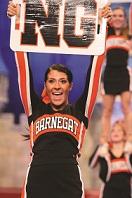

Because of the safety reviews and feedback from coaches, there were no new rules restrictions this year concerning cheer and dance; however, we are in the process of revising some of the wording on some of the rules to make things more clear, so that there can be no confusion about what is and is not permitted.
When we put limitations on skills, it is not something we do because we don’t want people to progress; in fact, it’s the opposite: we want them to do perform to the best of their ability. But we realize that every squad is made up of a variety of athletes. Some are more talented than others and have more well-developed skills. We don’t want to set rules based on the most talented athletes or on the least talented athletes; we want to set rules that create good safety standards for the sport.
Different Competitions for Different Forms of Cheer
When we talk about cheerleading, we basically address two different types: school cheer and all-star cheer. Each has a different purpose. All-star cheer programs are private; they are not affiliated with schools and they are generally competition-focused, with routines performed to music that is sometimes custom-designed. They may travel to competitions locally, regionally or nationally. They are also segregated by skill level; those range from level one to level six, with six being the most skilled athletes. That allows a coach to have teams with athletes who perform at a consistent level.
At the upper levels, all-star cheer athletes can really push the envelope, and it can be spectacular to watch. The United States All Star Federation recently hosted the annual Cheerleading and Dance World Championships. That’s where the top all-star teams competed at the highest level. Highlights of that competition and others like it can be found on YouTube, and give an example of the routines these athletes are performing.
School cheerleading, by comparison, is not meant to be primarily competitive. As a public school activity, it has a different focus. The true purpose of these programs is to lead the crowd, encourage the team and keep up the spirit during games. With a limited district from which they can choose their teams, the makeup of a high school team is different from that of an all-star team. It’s not necessary to have complicated routines with the flashy skills and the highest difficulty elements you’d see at an all-star event. That’s a level of liability exposure schools aren't willing to risk; after all, they are a public entity, and are responsible for public funds as well as maintaining the trust of the athletes’ parents and families.
That’s not to say school cheer doesn’t have competitions. In fact, one of the emerging forms of competition is called the Game Day Championship. It is a competition that addresses what school cheer is all about: encouraging the team and the crowd. Cheer squads are judged on the routines they would perform during games, and specifically, at points in a game such as during a time-out or in conjunction with their school fight song. In addition, cheer squads are asked to perform a sideline routine in response to a hypothetical situation: they might be told their team is in the playoffs and is down by one point and the opposing team has the ball. They then have to decide quickly which routine to perform in response to that scenario, and they’re judged on how suitable it is and how well they perform it. It requires the squad to have a number of routines ready, and to be able to think and perform on the fly, just the way they would in a game.
STUNT
STUNT is a discipline that is growing tremendously. It is a competition that uses the skills found in cheerleading – partner stunts, pyramids and tosses, tumbling and j umps – but it uses only two teams at a time, who perform against one another in a four-quarter, head-to-head competition.
umps – but it uses only two teams at a time, who perform against one another in a four-quarter, head-to-head competition.
In STUNT, the two teams take the floor at the same time. In the first quarter, the teams perform identical partner stunts. In the second quarter, they perform pyramids and tosses. In the third quarter, they do tumbling and jumps, and then in the fourth quarter, all those routines are performed back to back in what is called the Team Performance segment. Within each quarter, the teams will perform four 30-second routines based on that quarter’s focus. Scores are given immediately, and the team that is leading gets to call the next routine, adding an element of strategy that you wouldn’t see in a typical cheer competition.
STUNT is a great opportunity for athletes who have strong skills in a specific area (tumbling, for instance) but who might not be as skilled in other areas, such as pyramids or tosses. That might keep the athlete out of a traditional cheer program, but there’s still a place for them in STUNT, since they could be in the segment of the team that does tumbling.
We always recommend that people who are interested in STUNT look it up at usacheer.net and watch the competitions. They are very high-energy and exciting and they move along quickly. It’s totally different from a regular cheer competition, where people wait a long time to perform, and then have only a few minutes on the floor.
Currently, STUNT is being offered at the high school and college level (although it is not yet an NCAA sport). We also are starting to see interest in STUNT at the elementary and middle school levels, and even some club and all-star programs are looking into it. It is a discipline that is absolutely exploding and we expect it to continue to grow.
The Role of the Coach
The American Association of Cheerleading Coaches and Administrators was formed because we want cheerleading to remain safe. S

We realize kids want to learn and to progress, and we know they want to try the skills they have seen the more advanced teams do. (And with the advent of the Internet and social media, they can see those things all the time). But we’re always trying to tell them: those athletes you’re watching didn’t get where they are now because they stepped on the floor for the first time yesterday. They worked their way up to those skills.
In a sense, it’s our job as coaches to be the brakes on the train, to keep our athletes progressing at the appropriate speed. Falls and other injuries generally happen when kids try to do things before they’re ready. We want them to know they can move up to a higher skill level, but they have to master the current challenges first.
The More Things Change…
Cheer is a unique s


